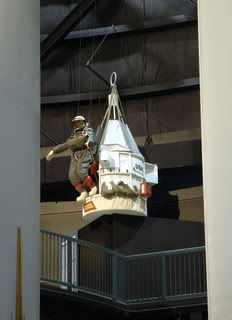 Kittinger's Excelsior III gondola
Kittinger's Excelsior III gondola 
Posted on 01/23/2010 1:39:48 AM PST by ErnstStavroBlofeld
A privately funded team will attempt this year to break a 50-year-old record for the highest-altitude parachute jump, floating a balloon well into the stratosphere before its pilot leaps out for a supersonic free fall.
The team behind the Red Bull Stratos mission announced details of the attempt here Friday morning in a media briefing. If all goes as planned, a towering helium balloon will loft Austrian-born skydiver and BASE jumper Felix Baumgartner, 40, roughly 37 kilometers into the air before he begins his descent. (BASE stands for "buildings, antennas, spans, Earth"—the places and structures from which a BASE parachutist jumps.) Baumgartner could set new records for the highest manned balloon flight and the longest free fall as well as become the first person to break the sound barrier without a protective craft. Baumgartner said he would exceed the speed of sound within about 35 seconds of free fall but would not pull his chute for another five minutes.
"It's human nature to want to go faster, farther," said Joe Kittinger, 81, the retired U.S. Air Force pilot who made the highest jump on record in 1960, parachuting from a balloon 31 kilometers above Earth's surface. Kittinger is the Stratos mission's capcom (short for capsule communicator), which means that he will be the voice in Baumgartner's helmet. Kittinger's advice to his successor: "Have fun, enjoy it, and tell us all about it when you get down."
Baumgartner, who called Kittinger a "childhood hero," is perhaps best known for gliding across the English Channel in 2003 with a carbon-fiber wing strapped to his back. Baumgartner said that jump, from about 10 kilometers, is his highest to date. The Stratos mission is incremental, with two lower-altitude jumps set to precede the final attempt; even the first jump, from roughly 20 kilometers, .
(Excerpt) Read more at scientificamerican.com ...
Free Fall from orbit!!
lol
It will NOT be the first supersonic drop...
Capt. Kittinger jumped from an altitude of 74,700 feet. On the third and last jump in Excelsior III on Aug. 16, 1960, Capt. Kittinger jumped from a height of 102,800 feet, almost 20 miles above the earth. With only the small stabilizing chute deployed, Capt. Kittinger fell for 4 minutes, 36 seconds. He experienced temperatures as low as minus 94 degrees Fahrenheit and a maximum speed of 614 miles per hour, exceeding the speed of sound.
 Kittinger's Excelsior III gondola
Kittinger's Excelsior III gondola 
"Question - Isn't it true that, on earth, where no object really falls "freely", there is a point at which the falling object finally attains zero acceleration? That is, could you say that, in reality, a falling object attains a maximum velocity above which it will not go?"
You are absolutely correct! Gravity accelerates an object high up in the air downward at the usual rate of 32 ft/second/second. As it accelerates, however, the air resistance increases, roughly like speed at low speeds and then more like the square of the speed. Finally, the air resistance exerts an upward force exactly equal and opposite to the force of gravity. The object will then continue to fall at that speed, which is called the terminal speed.
For a person in free fall, the terminal speed is about 60 m/s or 135 miles/hour. When his parachute opens (hopefully), the terminal speed is reduced to around 12 miles/hour.
Best, Dick Plano, Professor of Physics emeritus, Rutgers University
http://www.newton.dep.anl.gov/askasci/phy00/phy00800.htm
First Man in Space - Skydiving From The Edge Of The World
http://www.youtube.com/watch?v=81gn2oLeC_U
Terminal velocity will be a higher speed at higher altitudes due to the thinner air. At low altitudes, your figure is correct.
Great post ICE-Flyer.
Where I live there is a radio call in program called the Love Doctors.
Anyone can call in and bring up any subject.
Capt. Kittinger has been on the show a few times discussing his exploits.
Facinating and humble man.
When he describes the speed, temperature etc you find it hard to believe.
Also thanks for your military service.
I would think that it would all depend on air density, which would include altitude and temperature. I don't think this one speed would be a consistent number.
What is the air resistance “WAY UP THERE” ?? Is the normal terminal speed much higher?
There seems to be some disagreement. Googling “did kittinger break sound barrier?” turns up links that say he went to mach .9 and others that say he broke the sound barrier.
614 mph is correct but ......
Just what is the speed of sound?
http://en.wikipedia.org/wiki/Speed_of_sound
And here is a bit on Capt Kittinger’s jumps
http://www.aerospaceweb.org/question/aerodynamics/q0243.shtml
What some people are thinking of in simple terms is the speed of sound at sea level...it is FAR lower in the upper atmosphere as the air density is much lower. Speed of sound is easier to achieve at high altitudes.
So what is the speed of sound at 100,000 feet?
Even the good Captain (retired COL) never claimed to have gone through the sound barrier.
I forgot to add in my last post to you that they, and he, noted that he would have done it if he had gone a little over 4,000 feet higher.
Disclaimer: Opinions posted on Free Republic are those of the individual posters and do not necessarily represent the opinion of Free Republic or its management. All materials posted herein are protected by copyright law and the exemption for fair use of copyrighted works.